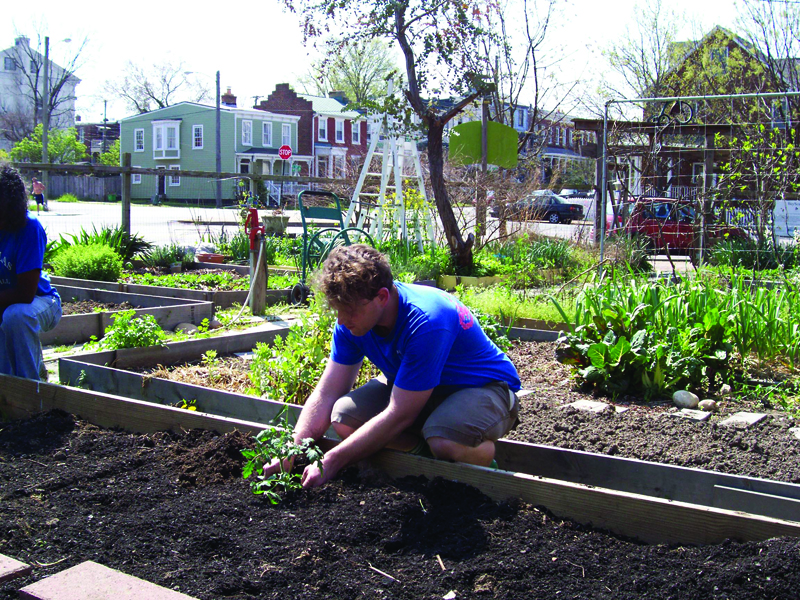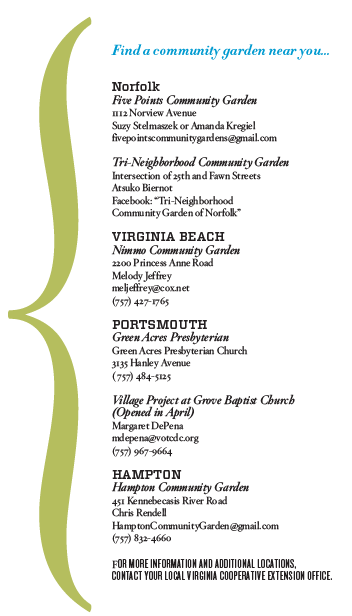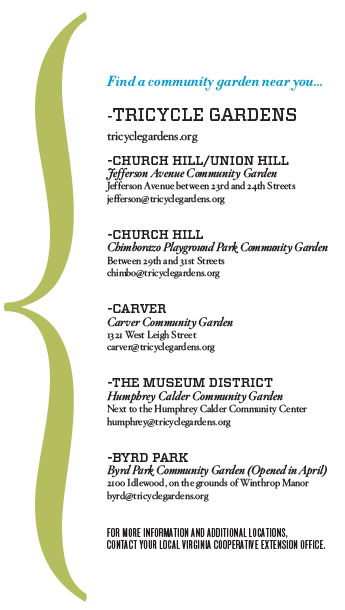Article and Photos By Heather McGinley
Community Gardens are a Growing Trend
Whether it serves as an “oasis” in a fresh food desert, an object of beauty and vitality in a steel and concrete jungle or a cornucopia overflowing with produce to share with impoverished neighbors, community gardens are gaining appeal and adding value to the communities they serve.
The aims and organization of community gardens vary according to the needs and desires of the particular community, explain garden organizers in Richmond and Hampton Roads. Some require an upfront rental and maintenance fee, which includes general upkeep, shared materials and activities, explains Stacey Moulds, one of the founders of Tricycle Gardens and steward of the Jefferson Avenue Community Garden in the Church Hill and Union Hill area of Richmond.
The five community gardens under the flag of Tricycle Gardens all follow a similar model of providing space to renters in urban areas to plant and harvest their own foods. Tricycle Gardens teaches sustainable practices through gardening workshops held at its central office and demonstration garden.
Similarly, the Five Points Community Garden in the Norview section of Norfolk, which began as a Five Points Farm Market outreach initiative to promote safety and well-being in the local community, rents plots to families and individuals and offers workshops to educate gardeners. However, Five Points Community gardeners are responsible not only for their plots but also for a portion of the community plots harvested to feed children through local church programs and Virginia Kids Eat Free.
The Nimmo Community Garden in Virginia Beach represents a third model in which the community donates all of the produce volunteers harvest to local food pantries, outreach groups and organizations supporting homeless and impoverished families in Pungo, Knotts Island and the oceanfront. Last year volunteers donated 1,500 pounds of summer produce and 500 pounds of fall and winter produce to area residents.
Funding and materials to maintain the garden come from the hosting Nimmo United Methodist Church and various businesses, churches, organizations and individuals, explains garden steward Melody Jeffery.
“Every community garden has its own structure. It really depends on the needs of the community,” says Suzy Stelmaszek, member of the Norfolk Community Gardens Advisory Committee and one of two garden managers for the Five Points Community Garden. “They are all so different, but the one trend that I see is that community gardens are really becoming popular.”
Stelmaszek, Moulds and Jeffery have observed the development of community gardens in nearby neighborhoods and an increased interest in their gardens over the last few years.
They explain that reasons for participating in gardens are as diverse as the communities the gardens serve.
Depending on the particular aims of the garden, it can teach sustainable practices, offer community service opportunities, increase an urban area’s access to fresh foods, reduce a neighborhood’s carbon footprint and establish common goals for community members, explains Isabel Eljaiek, graduate intern and spokesperson for Tricycle Gardens.
People become involved in community gardens to connect with other community members, to beautify urban areas, to provide their own food, to make a political statement, to save money, to understand the process of seed to plate and to establish a local food system, Eljaiek explains. “The beauty of community gardening is you can do so much with it.”
One way community gardens add value to a community is through teaching food literacy, Eljaiek says. In our fast food culture, children rarely see fresh fruits and vegetables. They often lack knowledge of what they look like and how they grow.
Past generations reaped the benefits of maintaining backyard gardens and learning the growing process from parents and other family members, but few families today have their own gardens, Jeffery explains.
“We’ve had kids come out to the garden who didn’t know what a potato was,” Stelmaszek adds. “To see them make that connection for the first time—it’s pretty awesome.”
—Suzy Stelmaszek,
Garden manager, Five Points Community Garden
The trend of community gardening spans economic, cultural and social barriers. It serves to unite community members of different ages with varying motivations and ideologies. “Those who grow food together definitely become a very tight knit community,” Eljaiek explains.
“That can be a really radical thing—to grow your own food,” she adds.
Although Stelmaszek recognizes that part of the increased interest in community gardening is due to the downturned economy, which has forced many to look for money-saving options, she also sees the interest as progressive. Recent books and movies have made consumers more aware of what they are eating and how their actions can affect the environment, she says.
“We are going there. And it’s a really exciting shift in global mentality, in self-sufficiency and living simply and making morally responsible choices,” Stelmaszek says.
Richmond:



